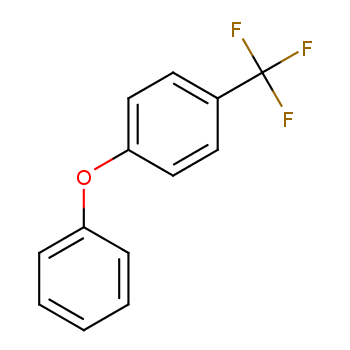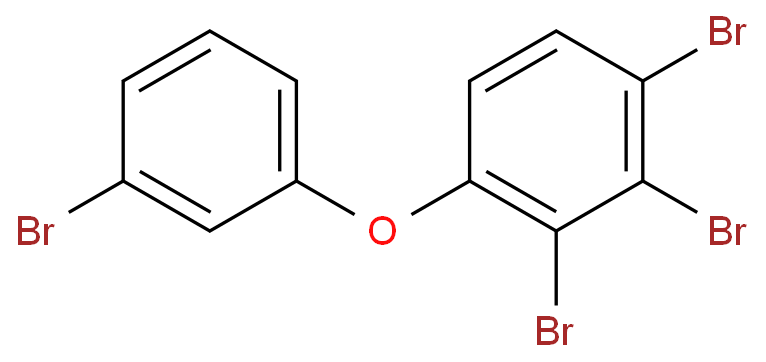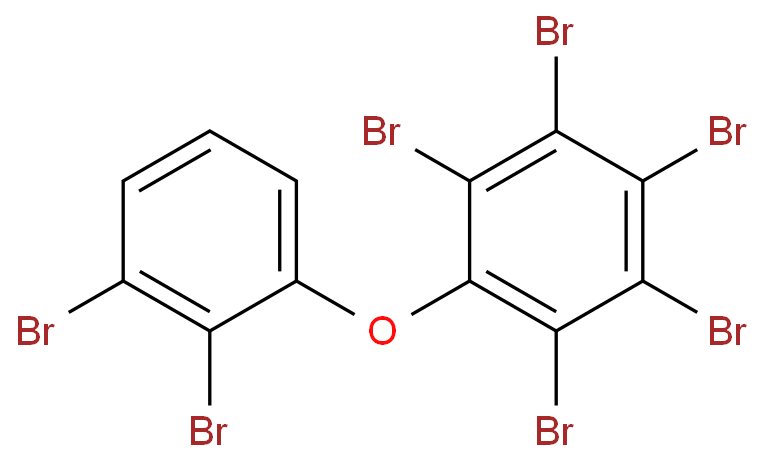Diphenyl ether
- Iupac Name:phenoxybenzene
- CAS No.: 101-84-8
- Molecular Weight:170.2072
- Modify Date.: 2022-11-01 22:43
- Introduction: Diphenyl ether (diphenyl oxide) is a colorless liquid with a floral odor. It is a white, crystalline solid at temperatures below 80ºF (27ºC). It has low volatility, low solubility in water, and is stable at high temperatures. Avoid contact with oxidizing materials.Liquid diphenyl oxide is used primarily in industry. It is used in the industrial setting as a heat transfer fluid. It is the major component of Dowtherm A® (an eutectic mixture of phenyl ether and biphenyl) and further as a chemical intermediate in the production of surface-active agents and hightemperature lubricants, and in perfumery due to its geranium-like odour (ACG99b). It is also used as a chemical intermediate in the manufacture of surfactants and fire retardants.Diphenyl oxide (DPO) is manufactured using the direct phenol method.
View more+
1. Names and Identifiers
- 1.1 Name
- Diphenyl ether
- 1.2 Synonyms
1,1'-oxybisbenzene 1,1'-Oxydibenzene 4,4'-diphenyl-ether 4-phenoxybenzene AKOS 90362 AKOS BBS-00004250 Benzene, 1,1'-oxybis- Biphenyl oxide biphenyloxide Chemcryl JK-EB chemcryljk-eb DEPHENYL OXIDE DIPHENYL OXIDE Diphenylether EINECS 202-981-2 ether, diphenyl Ether, diphenyl- FEMA 3667 MFCD00003034 Oxybisbenzene Oxydibenzene Oxydibenzol Oxydiphenyl Phenyl ethe Phenyl Ether Phenyl ether (8CI) Phenyl oxide
- View all
- 1.3 CAS No.
- 101-84-8
- 1.4 CID
- 7583
- 1.5 EINECS(EC#)
- 202-981-2
- 1.6 Molecular Formula
- C12H10O (isomer)
- 1.7 Inchi
- InChI=1S/C12H10O/c1-3-7-11(8-4-1)13-12-9-5-2-6-10-12/h1-10H
- 1.8 InChIkey
- USIUVYZYUHIAEV-UHFFFAOYSA-N
- 1.9 Canonical Smiles
- C1=CC=C(C=C1)OC2=CC=CC=C2
- 1.10 Isomers Smiles
- C1=CC=C(C=C1)OC2=CC=CC=C2
2. Properties
- 2.1 Density
- 1.073
- 2.1 Melting point
- 26-30℃
- 2.1 Boiling point
- 259℃
- 2.1 Refractive index
- 1.5795-1.5815
- 2.1 Flash Point
- 115℃
- 2.2 Precise Quality
- 170.073166
- 2.2 PSA
- 9.23000
- 2.2 logP
- 3.47890
- 2.2 Solubility
- alcohol: soluble(lit.)
- 2.3 Viscosity
- 3.4909X10-3 Pa-sec at melting point
- 2.4 VaporDensity
- >5.86 (25 °C, vs air)
- 2.5 Appearance
- clear pale yellowish liquid after melting
- 2.6 Atmospheric OH Rate Constant
- 9.60e-12 cm3/molecule*sec
- 2.7 Storage
- Ambient temperatures.
- 2.8 Autoignition Temperature
- 1148 °F (USCG, 1999)
- 2.9 Carcinogenicity
- Phenyl ether was not mutagenic in theAmes Salmonella assay with or without meta�bolic activation.
- 2.10 Chemical Properties
- Diphenyl oxide is a practically colorless crystalline solid with a strong geranium-like odor. clear pale yellowish liquid after melting. It is almost completely insoluble in water, but dissolves in most of the common organic solvents. Its high thermal stability at temperatures as high as 350 to 400°C. together with its noncorrosiveness and general chemical inertness make it eminently suitable as a component of high-boiling heat transfer media.
- 2.11 Physical Properties
- Colorless solid or liquid with a geranium-like odor. An experimentally determined odor thresholdconcentration of 100 ppbv was reported by Leonardos et al. (1969).
- 2.12 Color/Form
- MONOCLINIC, RHOMBIC CRYSTALS
COLORLESS LIQUID OR CRYSTALS
Colorless, crystalline solid or liquid (above 82 degees F).
- 2.13 Decomposition
- When heated to decomposition it emits acrid smoke and irritating fumes.
- 2.14 Heat of Combustion
- -1466.63 kcal/mol at 25 °C
- 2.15 Heat of Vaporization
- 15.99 kcal/mol at 25 °C
- 2.16 Ionization Potential
- 8.09 eV
- 2.17 Odor
- Geranium-like odor
- 2.18 Odor Threshold
- 0.1 ppm
- 2.19 pKa
- pK(BH+) = 5.79 at 25 °C /negative logarithm of ionization constant of protonated base/
- 2.20 Water Solubility
- insoluble
- 2.21 Spectral Properties
- INDEX OF REFRACTION: 1.5787 @ 25 DEG C/D; MAX ABSORPTION (ALCOHOL): 265 NM (LOG E= 3.20); 272 NM (LOG E= 3.28); 279 NM (LOG E= 3.23); SADTLER REFERENCE NUMBER: 4492 (IR, PRISM)
Intense mass spectral peaks: 170 m/z (100%), 141 m/z (39%), 51 m/z (36%), 77 m/z (35%)
IR: 4320 (Coblentz Society Spectral Collection)
UV: 1245 (Sadtler Research Laboratories Spectral Collection)
NMR: 200 (Sadtler Research Laboratories Spectral Collection)
MASS: 1126 (Atlas of Mass Spectral Data, John Wiley & Sons, New York)
- 2.22 Stability
- Stable under recommended storage conditions.
- 2.23 StorageTemp
- Store below +30°C.
- 2.24 Surface Tension
- 38.82 dyne/cm at 30 °C
3. Use and Manufacturing
- 3.1 Chemical Reactivity
- Reactivity with Water No reaction; Reactivity with Common Materials: No reaction; Stability During Transport: Stable; Neutralizing Agents for Acids and Caustics: Not pertinent; Polymerization: Not pertinent; Inhibitor of Polymerization: Not pertinent.
- 3.2 Definition
- ChEBI: An aromatic ether in which the oxygen is attached to two phenyl substituents. It has been found in muscat grapes and vanilla.
- 3.3 Purification Methods
- Crystallise the ether from 90% EtOH. Melt it, wash it with 3M NaOH and water, dry it with CaCl2 and fractionally distil it under reduced pressure. Fractionally recrystallise it from its melt and store over P2O5. [Beilstein 6 IV 562.] Diphenyl ether Preparation Products And Raw materials Raw materials
- 3.4 Usage
- Phenyl Ether is an Impurity of Propofol (P829750).
4. Safety and Handling
- 4.1 Symbol
- GHS07, GHS09
- 4.1 Hazard Codes
- Xi
- 4.1 Signal Word
- Warning
- 4.1 Risk Statements
- R36/37/38;R51/53
- 4.1 Safety Statements
- S26;S37/39;S57;S60
- 4.1 Packing Group
- III
- 4.1 Octanol/Water Partition Coefficient
- Log Kow = 4.21
- 4.2 Fire Hazard
- Diphenyl oxide is combustible.
- 4.3 Other Preventative Measures
- If material not on fire and not involved in fire: Keep sparks, flames, and other sources of ignition away. Keep material out of water sources and sewers. Build dikes to contain flow as necessary.
SRP: The scientific literature for the use of contact lenses in industry is conflicting. The benefit or detrimental effects of wearing contact lenses depend not only upon the substance, but also on factors including the form of the substance, characteristics and duration of the exposure, the uses of other eye protection equipment, and the hygiene of the lenses. However, there may be individual substances whose irritating or corrosive properties are such that the wearing of contact lenses would be harmful to the eye. In those specific cases, contact lenses should not be worn. In any event, the usual eye protection equipment should be worn even when contact lenses are in place.
SRP: Contaminated protective clothing should be segregated in such a manner so that there is no direct personal contact by personnel who handle, dispose, or clean the clothing. Quality assurance to ascertain the completeness of the cleaning procedures should be implemented before the decontaminated protective clothing is returned for reuse by the workers. Contaminated clothing should not be taken home at end of shift, but should remain at employee's place of work for cleaning.
The worker should immediately wash the skin when it becomes contaminated. /Vapor/
Work clothing that becomes wet or significantly contaminated should be removed and replaced. /Vapor/
Personnel protection: Avoid breathing vapors. Keep upwind. Avoid bodily contact with the material. Do not handle broken packages unless wearing appropriate personal protective equipment. Wash away any material which may have contacted the body with copious amounts of water or soap and water. If contact with the material anticipated, wear appropriate chemical protective clothing. - View all
- 4.4 Hazard Class
- 9
- 4.4 Hazard Declaration
- H319-H411
- 4.4 DisposalMethods
- SRP: At the time of review, criteria for land treatment or burial (sanitary landfill) disposal practices are subject to significant revision. Prior to implementing land disposal of waste residue (including waste sludge), consult with environmental regulatory agencies for guidance on acceptable disposal practices.
- 4.5 RIDADR
- UN 3077
- 4.5 Fire Fighting Procedures
- If material involved in fire: Extinguish fire using agent suitable for type of surrounding fire. (Material itself does not burn or burns with difficulty.) Use water in flooding quantities as fog. Cool all affected containers with flooding quantities of water. Apply water from as far a distance as possible.
Dry chemical, carbon dioxide. Water or foam may cause frothing.
- 4.6 FirePotential
- FIRE HAZARD: MODERATE WHEN EXPOSED TO HEAT OR FLAME.
- 4.7 Safety Profile
- Moderately toxic by ingestion. Prolonged exposure damages liver, spleen, kidneys, and thyroid, and upsets gastrointestinal tract. A skin and eye irritant. Combustible when exposed to heat or flame; can react with oxidizing materials. For explosion hazard, see ETHERS. To fight fire, use water, foam, CO2, dry chemical. When heated to decomposition it emits acrid smoke and irritating fumes
- 4.8 Caution Statement
- P273-P305 + P351 + P338
- 4.8 Formulations/Preparations
- GRADES: TECHNICAL; PERFUME; INDUSTRIAL
Technical and refined grades
Usual concns in final products: soap, 0.05%; detergent, 0.005%; creams, lotions, 0.05%; perfume, 0.15%
Eutectic heat-transfer mixture composed of 73.5% diphenyl oxide and 26.5% biphenyl...marketed under product names Dowtherm A (Dow Chemical), Therminol VP-1 (Monsanto), Thermex (Imperial Chem), Therm S-300 (Nippon Steel Chemical), Diphyl (Bayer), and Gilotherm (Progil)
- 4.9 WGK Germany
- 2
- 4.9 RTECS
- KN8970000
- 4.9 Protective Equipment and Clothing
- IN EVENT OF SPILLAGE OR LEAKAGE OF HOT FLUIDS, APPROVED CHEMICAL CARTRIDGE RESPIRATORS OR MASKS SHOULD BE WORN FOR PROTECTION AGAINST VAPORS. POSSIBILITY OF PROLONGED OR REPEATED SKIN CONTACT SHOULD BE AVOIDED BY PROPER HANDLING PROCEDURES. /DIPHENYL & DERIVATIVES/
Goggles or face shield; rubber gloves.
Wear appropriate personal protective clothing to prevent skin contact. /Vapor/
Wear appropriate eye protection to prevent eye contact. /Vapor/
Recommendations for respirator selection. Max concn for use: 25 ppm. Respirator Class(es): Any supplied-air respirator operated in a continuous flow mode. Eye protection needed. Any powered, air-purifying respirator with organic vapor cartridge(s) in combination with a dust and mist filter. Eye protection needed. /Vapor/
Recommendations for respirator selection. Max concn for use: 50 ppm. Respirator Class(es): Any chemical cartridge respirator with a full facepiece and organic vapor cartridge(s) in combination with a high-efficiency particulate filter. Any air-purifying, full-facepiece respirator (gas mask) with a chin-style, front- or back-mounted organic vapor canister having a high-efficiency particulate filter. Any self-contained breathing apparatus with a full facepiece. Any supplied-air respirator with a full facepiece. /Vapor/
Recommendations for respirator selection. Max concn for use: 100 ppm. Respirator Class(es): Any supplied-air respirator that has a full facepiece and is operated in a pressure-demand or other positive-pressure mode. /Vapor/
Recommendations for respirator selection. Condition: Emergency or planned entry into unknown concn or IDLH conditions: Respirator Class(es): Any self-contained breathing apparatus that has a full facepiece and is operated in a pressure-demand or other positive pressure mode. Any supplied-air respirator with a full facepiece and operated in pressure-demand or other positive pressure mode in combination with an auxiliary self-contained breathing apparatus operated in pressure-demand or other positive pressure mode. /Vapor/
Recommendations for respirator selection. Condition: Escape from suddenly occurring respiratory hazards: Respirator Class(es): Any air-purifying, full-facepiece respirator (gas mask) with a chin-style, front- or back-mounted organic vapor canister having a high-efficiency particulate filter. Any appropriate escape-type, self-contained breathing apparatus. /Vapor/ - View all
- 4.10 Reactivities and Incompatibilities
- Strong oxidizers. /Vapor/
- 4.11 Report
-
Diphenyl ether and many of its properties were first reported as early as 1901.It is synthesized by a modification of the Williamson ether synthesis, here the reaction of phenol and bromobenzene in the presence of base and a catalytic amount of copper:
PhONa + PhBr → PhOPh + NaBr
Involving similar reactions, diphenyl ether is a significant side product in the high-pressure hydrolysis of chlorobenzene in the production of phenol
- 4.12 Skin, Eye, and Respiratory Irritations
- AT CONCN OF 7-10 PPM /OF DOWTHERM/, VAPOR CAUSES BURNING OF EYES, IRRITATION OF RESPIRATORY TRACT... /DOWTHERM/
Contact of liquid with eyes causes mild irritation. Prolonged exposure of skin to liquid causes reddening and irritation.
- 4.13 Safety
-
Hazard Codes:?  N,
N, Xi,
Xi, T
T
Risk Statements:?51/53-36/37/38-39/23/24/25-23/24/25-36/38
51/53:? Toxic to aquatic organisms, may cause long-term adverse effects in the aquatic environment?
36/37/38:? Irritating to eyes, respiratory system and skin?
39/23/24/25:? Toxic: danger of very serious irreversible effects through inhalation, in contact with skin and if swallowed?
23/24/25:? Toxic by inhalation, in contact with skin and if swallowed?
36/38:? Irritating to eyes and skin
Safety Statements:?60-61-57-37/39-26-45-36/37
60:? This material and/or its container must be disposed of as hazardous waste?
61:? Avoid release to the environment. Refer to special instructions safety data sheet?
57:? Use appropriate container to avoid environmental contamination?
37/39:? Wear suitable gloves and eye/face protection?
26:? In case of contact with eyes, rinse immediately with plenty of water and seek medical advice?
45:? In case of accident or if you feel unwell, seek medical advice immediately (show label where possible)?
36/37:? Wear suitable protective clothing and gloves
RIDADR: UN 3077 9/PG 3
WGK Germany:?2
HazardClass:?9
- View all
- 4.14 Specification
-
? Diphenyl ether (CAS NO.101-84-8), its Synonyms are Benzene, 1,1'-oxybis- ; Benzene, phenoxy- ; Biphenyl oxide ; Diphenyl oxide ; Geranium crystals ; Oxybisbenzene ; Oxydiphenyl ; Phenoxybenzene ; Phenyl ether ; Phenyl oxide .
- 4.15 Toxicity
-
| Organism |
Test Type |
Route |
Reported Dose (Normalized Dose) |
Effect |
Source |
| rabbit |
LD50 |
skin |
> 7940mg/kg (7940mg/kg) |
BEHAVIORAL: SOMNOLENCE (GENERAL DEPRESSED ACTIVITY)
LUNGS, THORAX, OR RESPIRATION: ACUTE PULMONARY EDEMA |
National Technical Information Service. Vol. 0TS0518143, |
| rat |
LD50 |
oral |
2450mg/kg (2450mg/kg) |
BEHAVIORAL: FOOD INTAKE (ANIMAL)
BEHAVIORAL: MUSCLE WEAKNESS
GASTROINTESTINAL: OTHER CHANGES |
National Technical Information Service. Vol. 0TS0518143, |
- View all
5. MSDS
2.Hazard identification
2.1 Classification of the substance or mixture
Eye irritation, Category 2A
Hazardous to the aquatic environment, short-term (Acute) - Category Acute 1
Hazardous to the aquatic environment, long-term (Chronic) - Category Chronic 3
2.2 GHS label elements, including precautionary statements
| Pictogram(s) |   |
| Signal word | Warning |
| Hazard statement(s) | H319 Causes serious eye irritation H411 Toxic to aquatic life with long lasting effects |
| Precautionary statement(s) | |
| Prevention | P264 Wash ... thoroughly after handling. P280 Wear protective gloves/protective clothing/eye protection/face protection. P273 Avoid release to the environment. |
| Response | P305+P351+P338 IF IN EYES: Rinse cautiously with water for several minutes. Remove contact lenses, if present and easy to do. Continue rinsing. P337+P313 If eye irritation persists: Get medical advice/attention. P391 Collect spillage. |
| Storage | none |
| Disposal | P501 Dispose of contents/container to ... |
2.3 Other hazards which do not result in classification
none
7. Synthesis Route
101-84-8Total: 139 Synthesis Route
8. Other Information
- 8.0 Usage
- Diphenyl ether is widely used as a heat transfer agent and a dye carrier. It is employed as a processing aid in the production of polyesters. It acts as a chemical intermediate in the production of surface active agents and high temperature lubricants, fire retardants like polybrominated diphenyl ethers (PBDEs) and fragrance for detergents. It plays a vital role in the Ferrario reaction to produce phenoxathiin, which finds application in polyamide and polyimide production.
- 8.1 Merck
- 14,7288
- 8.2 BRN
- 1364620
- 8.3 毒性
- GRAS(FEMA)。
- 8.4 Description
- Diphenyl ether (diphenyl oxide) is a colorless liquid with a floral odor. It is a white, crystalline solid at temperatures below 80oF (27oC). It has low volatility, low solubility in water, and is stable at high temperatures. Avoid contact with oxidizing materials.
Liquid diphenyl oxide is used primarily in industry. It is used in the industrial setting as a heat transfer fluid. It is the major component of Dowtherm A? (an eutectic mixture of phenyl ether and biphenyl) and further as a chemical intermediate in the production of surface-active agents and hightemperature lubricants, and in perfumery due to its geranium-like odour (ACG99b). It is also used as a chemical intermediate in the manufacture of surfactants and fire retardants.
Diphenyl oxide (DPO) is manufactured using the direct phenol method.

- 8.5 Chemical Properties
- Diphenyl oxide is a practically colorless crystalline solid with a strong geranium-like odor. clear pale yellowish liquid after melting. It is almost completely insoluble in water, but dissolves in most of the common organic solvents. Its high thermal stability at temperatures as high as 350 to 400°C. together with its noncorrosiveness and general chemical inertness make it eminently suitable as a component of high-boiling heat transfer media.
- 8.6 Chemical Properties
- Diphenyl Ether has not been observed in nature. It is a colorless liquid or a crystalline solid (mp 26.8°C) with an odor reminiscent of geranium leaves. Diphenyl ether is obtained as a by-product in the production of phenol by high-pressure hydrolysis of chlorobenzene. Because of its stability and low price, diphenyl ether is used in large quantities in soap perfumes.
- 8.7 Chemical Properties
- Diphenyl ether has a harsh, floral-green, metallic geranium-type odor.
- 8.8 Physical properties
- Colorless solid or liquid with a geranium-like odor. An experimentally determined odor threshold concentration of 100 ppbv was reported by Leonardos et al. (1969).
- 8.9 Occurrence
- Reported found in muscat grapes, grilled beef, green tea, potato chips, buckwheat, Bourbon vanilla and lemon balm.
- 8.10 Uses
- Phenyl Ether is an Impurity of Propofol (P829750).
- 8.11 Uses
- Diphenyl ether is widely used as a heat transfer agent and a dye carrier. It can be used alone or as a mixture with other materials. Because of its reactivity, It can also be used as a raw material or chemical intermediate to produce commercial products. Diphenyl ether is used in the production of:
- Diphenyl ether is employed as a processing aid in the production of polyesters. It acts as a chemical intermediate in the production of surface active agents and high temperature lubricants, fire retardants like polybrominated diphenyl ethers (PBDEs) and fragrance for detergents.
- Heat transfer media – like DOWTHERMTM fluids used for heating industrial processes
- Alkylated diphenyl oxides – used to make surfactants, greases and lubricants
- Halogenated diphenyl oxides – used in insecticides, wood preservatives, and flame retardants for appliance casings in consumer electronic products
- High temperature solvents
- Coatings
- Textile dye labeling
- Plastics – like ethylene-propylene-diene monomer (EPDM) rubber that is used for membrane roofing materials
- Diphenyl ether plays a vital role in the Ferrario reaction to produce phenoxathiin, which finds application in polyamide and polyimide production. Involving similar reactions, diphenyl ether is a significant side product in the high-pressure hydrolysis of chlorobenzene in the production of phenol.
- Diphenyl ether is found in alcoholic beverages. Diphenyl ether is present in muscat grapes, green tea, vanilla, lemon balm, buckwheat, potato chips and grilled beef. Diphenyl ether is a flavouring ingredient.
- View all
- 8.12 Uses
- Heat-transfer medium; in perfuming soaps; in organic syntheses
- 8.13 Definition
- ChEBI: An aromatic ether in which the oxygen is attached to two phenyl substituents. It has been found in muscat grapes and vanilla.
- 8.14 Preparation
- By heating potassium phenolate with bromobenzene or with chlorobenzene at elevated temperatures.
- 8.15 Aroma threshold values
- Aroma characteristics at 1.0%: grassy, musty, powdery, dry, terpy, ocimenelike, aromatic and hoplike with green juniper berry nuances.
- 8.16 Taste threshold values
- Taste characteristics at 10 ppm: dry chemical, floral rosey with carrot, tropical and hoplike terpy notes and a green vegetative and woody nuance.
- 8.17 Synthesis Reference(s)
- Synthetic Communications, 13, p. 335, 1983 DOI: 10.1080/00397918308066985
Synthesis, p. 204, 1991 DOI: 10.1055/s-1991-26419
- 8.18 General Description
- Colorless liquid with a mild pleasant odor. May float or sink in water. Freezing point is 81°F.
- 8.19 Air & Water Reactions
- Insoluble in water.
- 8.20 Reactivity Profile
- Diphenyl oxide can react with oxidizing materials. . A vigorous reaction occurred between the ether and chlorosulfuric acid.
- 8.21 Health Hazard
- Inhalation may cause nausea because of disagreeable odor. Contact of liquid with eyes causes mild irritation. Prolonged exposure of skin to liquid causes reddening and irritation. Ingestion produces nausea.
- 8.22 Fire Hazard
- Diphenyl oxide is combustible.
- 8.23 Chemical Reactivity
- Reactivity with Water No reaction; Reactivity with Common Materials: No reaction; Stability During Transport: Stable; Neutralizing Agents for Acids and Caustics: Not pertinent; Polymerization: Not pertinent; Inhibitor of Polymerization: Not pertinent.
- 8.24 Safety Profile
- Moderately toxic by ingestion. Prolonged exposure damages liver, spleen, kidneys, and thyroid, and upsets gastrointestinal tract. A skin and eye irritant. Combustible when exposed to heat or flame; can react with oxidizing materials. For explosion hazard, see ETHERS. To fight fire, use water, foam, CO2, dry chemical. When heated to decomposition it emits acrid smoke and irritating fumes
- 8.25 Carcinogenicity
- Phenyl ether was not mutagenic in the Ames Salmonella assay with or without meta�bolic activation.
- 8.26 Purification Methods
- Crystallise the ether from 90% EtOH. Melt it, wash it with 3M NaOH and water, dry it with CaCl2 and fractionally distil it under reduced pressure. Fractionally recrystallise it from its melt and store over P2O5. [Beilstein 6 IV 562.]
9. Computational chemical data
- Molecular Weight: 170.2072g/mol
- Molecular Formula: C12H10O
- Compound Is Canonicalized: True
- XLogP3-AA: null
- Exact Mass: 170.073164938
- Monoisotopic Mass: 170.073164938
- Complexity: 116
- Rotatable Bond Count: 2
- Hydrogen Bond Donor Count: 0
- Hydrogen Bond Acceptor Count: 1
- Topological Polar Surface Area: 9.2
- Heavy Atom Count: 13
- Defined Atom Stereocenter Count: 0
- Undefined Atom Stereocenter Count: 0
- Defined Bond Stereocenter Count: 0
- Undefined Bond Stereocenter Count: 0
- Isotope Atom Count: 0
- Covalently-Bonded Unit Count: 1
- CACTVS Substructure Key Fingerprint: AAADccBwIAAAAAAAAAAAAAAAAAAAAAAAAAAwYAAAAAAAAAABQAAAGgAAAAAACASAkAAwBoAABACAACBCAAACCAAgIAAIiAAGCIgMJiKEMRqCOCCkwBEIqAeAQAAAAAAAAAAAAAAAAAAAAAAAAAAAAAAAAA==
10. Question & Answer
-
Varieties of Diphenyl ether herbicides There are 11 species of diphenyl ether herbicides developed globally, including fomesafen, lactofen, oxyfluorfen, acifluorfen, bifenox, ethoxyfen-ethyl, fluorogl..
-
Introduction of Diphenyl ether Diphenyl ether, also known as phenoxybenzene, is a colourless liquid with a mild pleasant odour. It can either float or sink, and has a freezing point of 81 °F. This aro..
-
Diphenyl ether is a widely used organic compound in the pharmaceutical industry. It plays a crucial role as a raw material in the pharmaceutical process and requires strict quality control. The main ..
-
Diphenyl ether, also known as phenyl ether, is a colorless oily liquid or crystalline substance with a faint, refreshing fragrance of geranium leaves. It has a relative density of 1.086, a melting poi..
11. Recommended Suppliers
-
- Products:finechemicals, pharmaceutical materials and intermediates, pesticides, dyes andbiochemical reagents.
- Tel:86-571-56123425
- Email:purchase@kieraychem.com
-
- Products:API & Intermediates, Food Addititives,Fine Chemicals. Biochemical & Reagent
- Tel:86-27-59207850
- Email:info@fortunachem.com
-
- Products:carbomer940,uv627
- Tel:86-311-15028179772
- Email:betty@hbmojin.com
-
- Products:API',s intermediates,fine chemicals and plant extracts.
- Tel:86-917-3909592
- Email:gksales1@gk-bio.com
-
- Products:Manufacture & Supply Biopharm Chemical, Specialty Chemical, PetroChemical.
- Tel:86-592-8883942
- Email:sale@amitychem.com
12. Realated Product Infomation


 N,
N, Xi,
Xi, T
T 











